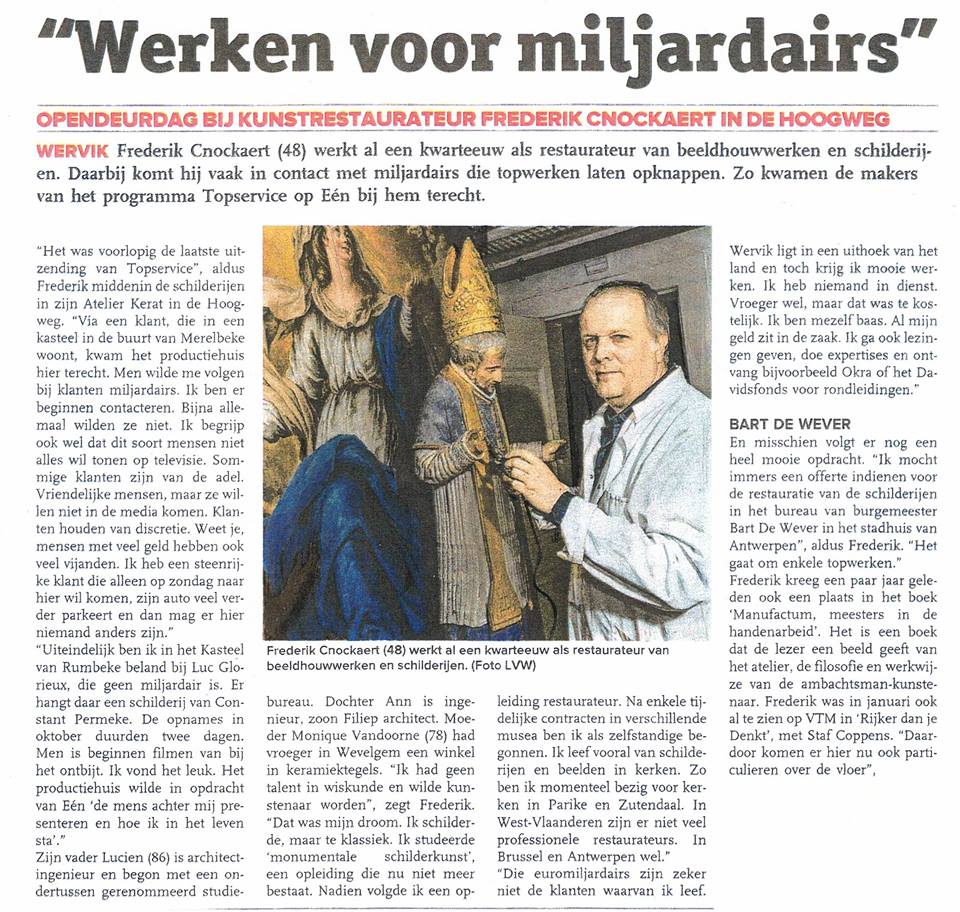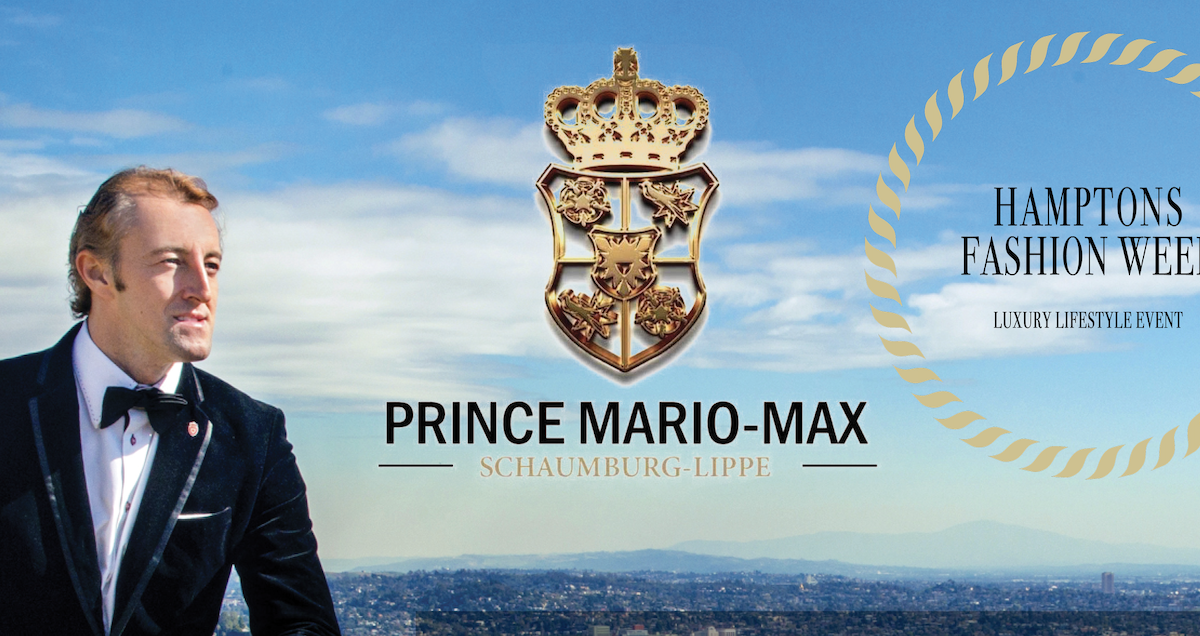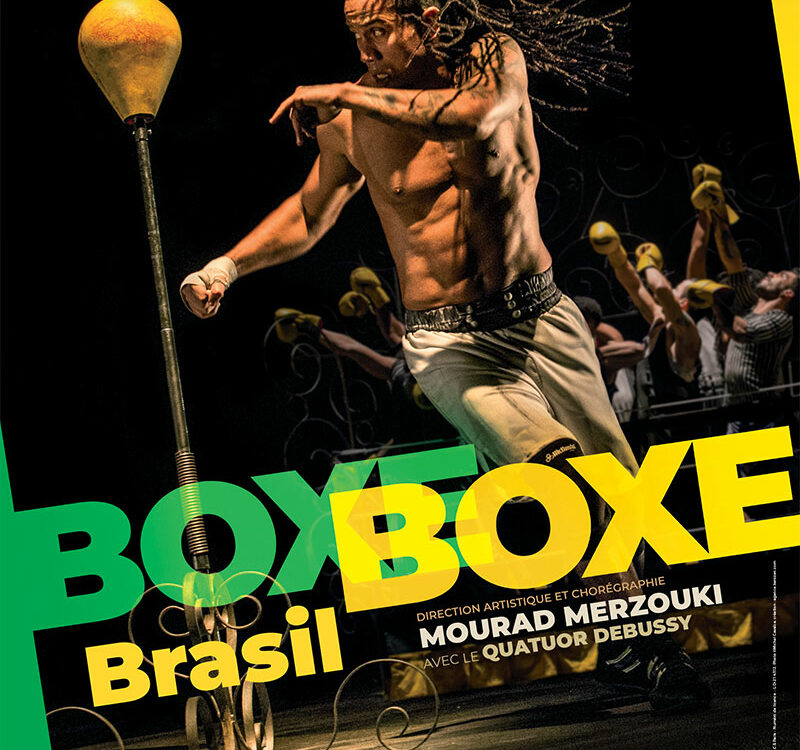Frederik Cnockaert the restorer
Studied at St. Lucas Institution in Gent (1986 –1990)
Qualification: plastic artist, followed by post-graduate qualification “restoration of works of art” at the Royal Academy of Arts (1990 –1994)
Between 1992 and 1994 practical training at the Museums of the city of Antwerp. During this training he restored – amongst other paintings – an oil painting on panelled wood of Pieter Paul Rubens (The dying Seneca) in the Plantin Moretus Museum and ? of the National Navigation Museum.
From1995 till 2002 full-time restorer at the Museums of Bruges. Restoration of – amongst other masterpieces- the well-known polychrome bust of the young emperor Charles, by Conrad Meit. Restoration of a few panels of Pieter Claeissens and Pieter Pourbus (16th century). A very remarkable and important work was the restoration of the murals of René De Pauw in Bruges’ train station hall (1996).
In 2002 establisment as independent restorer in Wervik: Kerat (Kunst en Restauratie-Atelier), with diverse specialisations, performed by specialist craftsmen: paintings on canvas or wood, but also polychrome sculptures and restoration of paper. 15 years of experience in restoration performed for private persons and public institutions. A short survey: 2002: 10 murals by Theodoor De Bruyn in the Plantin-Moretus museum (18th century)
Works from the public arts patrimony: Town hall of Brussels (2002 and 2004), the church of Haasdonk (2003), St. Gislenus Church in Sint-Niklaas (2004-2005), the abbey of Colen-Kerniel (2004 prize of Flemish monuments) and six large 17th century paintings (among which ‘the adoration of the magi’ by Theodoor van Loon) in the church of the beguinage in Brussels (2005). ‘restoration of paintings’ teacher at Syntra. He is a Member of commission Reform of Art Education VIZO. Recently: restoration of paintings of the Royal Family. Kerat works for museums, churches, public institutions, insurances, antique dealers and private persons. The restorations comprise big masters as Tintoretto, Jordaens, Rubens, De Heem, … as well as works of art with a sentimental value.
We interviewed Frederik about his work as a restorer
1.How did you come to this profession ?
I studied first for artist en after graduation came to the conclusion that is not my calling to be a great artist. Then i decided to study restoration of art.
Works in Wervik sinci 2002 with his company Kerat art restoration. In Wervik, hidden between the greenery, lies the studio where Fred- erik Cnockaert restores artworks. It is a large building with plenty of light and space to freshen up, restore or conserve the various types of artworks he receives. Cnockaert learnt the trade at specialised schools and gained an impressive amount of work experience at im- portant museums in Flemish cities famous for their art. The most beautiful piece he has ever been allowed to restore was a painting by Theodoor van Loon, a contemporary of Rubens. Restoring artworks requires knowledge of all types of painting tech- niques and materials, and the experience to be able to repair the damage flawlessly. Frederik Cnockaert has both. At the Higher Institute for Fine Arts Saint-Luke’s in Ghent, he got his degree in Monumental Fine Arts. He went on to receive a postgraduate in conservation and restoration of artefacts at the Royal Academy of Fine Arts, also in Ghent. At the Royal Academy of Fine Arts in Antwerp, he perfected his gold leaf techniques and mastered restoring polychromy on statues.
2.What kind of work do you prefer to work on ?
I liked in the beginning old master paintings, but now i also love modern art to work on
The clients that come to him for restorations or advice are quite diverse. Both professionals (gallery owners, antiquarians, architects, cultural her- itage consultants), as well as private collectors find their way to Kerat. Over the years, the number of jobs for the government (public boards, museums and church wardens) have also increased. Insurance compa- nies come to him for his expert advice on damaged artworks that were insured with them. Or to have them repaired or restored. Restoration doesn’t have to be expensive. Often times, just replacing the dull or discoloured varnish gives the work a whole new, fresh look. And sometimes, the painting turns out to be worth more than the owner thought. Visibly authentic A clear trend in the past years, especially when it comes to important works, has been that clients have been asking for conservation in favour of restoration. They no longer want their artwork to be restored to its.
With his studies, Cnockaert could have also become a fine arts painter. But it doesn’t appeal to him, it isn’t his calling. Restoring is it. After his stud- ies, he restored paintings for the Museum of Fine Arts and the Museum of Industrial Archaeology and Textiles (MIAT) in Ghent. He went on to work in museums in Antwerp and in Bruges, he was the conservator-re- storer for several historical city museums, such as the Groenige Museum, the Gruuthuse Museum and many others, for eight years. The time was right In 2002, he established himself in Wervik as an independent restorer, with his company Kunst En Restauratie ATelier (Art and Restoration Studio)
Kerat: The timing was perfect and the assignments were soon coming in. Since then, he works on old and modern artefacts: paintings on canvas, copper, paper or wood and their frames; statues in stone, plaster or wood, polychrome or not; and various paper media. He cleans, retouches, replaces varnishes, removes old repairs, treats against woodworm and fungi, adds a protective layer, repairs, relines… original state, but often want to prevent further decay. It’s more interest- ing to be able to discern the authentic parts of an artwork. Sometimes, customers are surprised when research shows that their art- work wasn’t done by a famous master, as they had hoped. There are many copies of works by the great masters, and they too can be very beautiful and valuable. Kerat recently restored a painting by Abraham Janssen, a contempo- rary of Rubens, which has been said to have been painted by a student of Rubens. Sometimes a signature is suddenly found under the dirt on a painting. Such as a quite dirty and repainted work by Van der Neer from the 17th century, Cnockaert recalls. Whatever the case may be, any art- work that has been made with skill deserves to be treated with respect. Especially by the restorer.
About art on request: about forgeries, the line between art and kitsch, the worth or date and style of an artwork
And you can also make an appointment for a tour of his workshop. Scientific research Sometimes, a diagnoses is easy to make. You can often use an ultraviolet lamp in a dark room to see the layers painted over a work and the under- lying damage to a painting. If a work is worth it, or if the client specifically requests it, Cnockaert has x-rays made of the piece, to get more informa- tion. If necessary, he uses a lab to research the material. The restorer-conservator makes a good case for taking decent care of artworks. Paintings, sculptures and graphic designs are constantly ex- posed to light and fluctuations in temperature and humidity. Advice for the optimum care or a preventative examination can keep artworks from being damaged. Kerat studios uses the most appropriate and tried and true methods and techniques of restoration, either old or modern, whichever suit the na- ture of the artefact to be restored. Clients that come to Kerat with an art- work first receive a proposition for a certain treatment and a clear price: everyone stands to gain from clear agreements. For each restoration, Cnockaert makes a dossier, complete with descrip- tions, explanatory notes and photographs. Such a file can be exception- ally handy when it comes to later treatments. It also helps with identification purposes should an artwork be stolen.
3.How much work is behind every work?
That depends on wich work en the damage that is done….I ask my self the question. Is it a painting that needs in-depth cleaning?
Is this a canvas with rents, rips or dents, a panel showing cracks, a frame missing pieces of ornament, are past interventions very visible,have past retouches discoloured or is the pictorial layer coming loose from its support?
A conservator restores damaged, contaminated and obliterated paintings. To provide appropriate cure and care the state of repair is analysed, the painting is separated from its frame or support, the picture support (canvas, panel, copper, cardboard) is examined and the pictorial (paint, pigments, charcoal, pastel) layer is conservated and /or restored. A conservator carries out assignments both on site (in case this would be required because of exceptional art-historical and/or insurance value or if transport cannot be justified due to large dimensions and/or state of the masterpiece) as well as in his own atelier.
Conservation of old and modern masters on panel, canvas, copper and other supports
Depending on the type and degree of damages, previous treatments and the techniques applied by the artist, a detailed treatment plan is defined based on an extensive preliminary examination.
Conservation relates to those operations during which the painting is consolidated against further deterioration by means of minimal, reversible direct interventions (curative conservation) or indirect measures (preventive conservation).
Restoration implies that in addition to the conservation more thorough interventions like relining, cleaning and retouching are performed with regard for the aesthetic, historic and physical integrity of the work of art.I am specialised in 16th, 17th, 18th century paintings.
One needs to draw a distinction between paintings on canvas and those on wood. The interventions to the front side by the artist and later on, by the conservator, are almost identical as they relate to the pictorial layer. The conservation of a panel however requires highly specialized conservation expertise and know-how. A conservator specializing in panel paintings has to know and sense the peculiarities of woodwork to be able to treat the backside of the panel professionally and effectively.
Rules of engagement
Care and cure of our national heritage honours the principle that the proprietary importance of cultural heritage relates to the transfer of information; a work of art being a messenger. This is extremely true if we consider paintings in this context. Our mission encompasses the preservation of those messages as legible and undamaged as possible, for the benefit of present and future generations. Conservation strives to preserve the historical message with maximum care and cure for the physical messenger.
Focus is clearly on the ‘care’ aspect rather than actively making messages legible again, in which case all intervention needs to be kept inferior to the historical relevance.
Present conservation deontology attaches the greatest importance to the reversibility of all interventions. Based on respect for unicity and authenticity of the depiction, every conservation intervention needs to be 100% reversible, so that it can be easily reversed should that be required later on. Products used have to be easily removable; retouches have to subtle and easy to be taken off again. Even if a conscientious conservator will always strive to work according to the latest techniques, the present future will surely present new and better techniques and instruments. When that day will dawn, one needs to be able to remove the current conservation treatment without any harm, in order to be able to apply more advanced conservation techniques. According to the views of conservation professionals in the narrow sense of the word, one should always attempt to preserve the authentic work of art, even if this implies that a number of lacunas will remain visible.
Methodology and techniques
All techniques are applied in conformity with the guidelines of the Royal Institute for the National Heritage (KIK, Belgium), as well as the international ICOM-CC charter.
Several products and agents are manufactured in-house and new developments are kept up with.
Conservation of picture frames
Picture frames can be equally fragile because of dislodged ornaments.
Because of dehydration and shrinkage of the wood the joints start to show cracks and decoration elements give way. Embellishments in gold leaf and semi-precious metals tend to wear out when overzealously cleaned.
In case a painting is to be treated, simultaneous conservation or even restoration of the original frame is strongly recommended. Picture frame and painting constitute inextricably the art-historical value of a work of art.Valuation in the context of inheritances and production of insurance
Market demand for reliable and professional art experts has increased significantly. Retail prices for art and antiques have been climbing year on year and made this flourishing market extremely appealing to forgers, extortionists and swindlers. Increasingly sophisticated techniques applied to the production of good quality forgeries, the limited know-how of certain art dealers, the sale of antiques outside of the official circuit… all add to complicating matters for the art scene.
Determination of authenticity can be done using a plethora of methodologies:
Art connoisseurs with a thorough knowledge of painting styles and components identify counterfeit paintings based on an unlikely choice of subject, brush technique, quality of the signature, combination of component and a whole range of other decisive elements.
Very often is a further investigation using advanced techniques required to measure the quality of materials applied.The identification of certain pigments and binding agents can provide indication that a painting could impossibly have been produced in a supposed period.
Chemical analysis of paint, varnish and the age of wood and canvas can give a decisive answer about the attribution of a painting to a period in time.
Art-historical research is extremely valuable for the discovery of the exact provenance of a work of art.Non-destructive analyses such as rontgen analysis (identifies the presence of specific radiation-absorbing pigments such as white lead), infrared analysis (during which invisible IR light penetrates the darkest layers of paint to visualize sketches, hence a drawing style) and ultraviolet fluorescence analysis (invisible UV light makes certain pigments brighten and provides proof of the substances used) all provide strong indications. The individual conservator concentrates chiefly on IR and UV analysis.

Frederik Cnockaert
KERAT Frederik Cnockaert
Hoogweg 42
B – 8940 Wervik
+32 56 22 67 97
info@kerat.be
www.kerat.be







